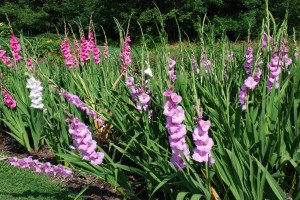Across most regions of the U.S., planting gladiola corms (they’re not really “bulbs”) begins a week before the probable frost-free date has passed in the spring. Stagger individual plantings every 2-3 weeks through mid- July. Many people opt to grow them as cutflowers for their homes.
Purchase large or premium sized corms that measure 1 1/4 to 1 1/2 inches across; quality corms produce tall floral scapes in wide color array. Floral scapes range from 18 to 36 inches high depending on variety. Bargain bulbs produce smaller sized individual flowers and shorter scapes.
Glads grow in full sun and in average well-drained soil. Compost-rich, slightly acidic soil is best. Roto-till the ground to at least a 6-inch depth. Add a slow-release fertilizer designated for flowering bulbs according to package directions.
Sow bulbs 4-6 inches deep and 6 inches apart, pointy side up. If rainfall is lacking, glads should be irrigated weekly at least 1 inch of water. Add a 2-3 inch layer of organic mulch to conserve soil moisture. Staking each row of glads as plants often become top heavy when floral scapes are heavily budded up. Place a heavy duty post or stake at opposite ends of the row and weave two sturdy cords through the glads about 2-3 weeks prior to bloom when scapes are beginning to form.
Thrips are a serious pest of glads. Thrips are very tiny and tend to congregate inside the flowers, reducing floral life. Several insecticides, including soaps, are labeled for managing heavy thrip populations.
In most areas of the U.S. where winter temperature dip below 25º F, treat gladiolas as annuals (USDA hardiness zone 7 and northward). Some gardeners dig, clean off soil, and divide the corms in the fall. Grade by size and throw away all rotted or poorly formed corms. Undersized corms, called “cormels”, are usually discarded or planted in a nursery bed next spring to grow and size up. During winter glads are stored in mesh bags and stored in a cool area (36-41º F) that does not freeze.


 Posted in
Posted in 
